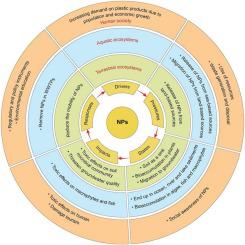Journal of Hazardous Materials ( IF 13.6 ) Pub Date : 2020-07-08 , DOI: 10.1016/j.jhazmat.2020.123415 Liuwei Wang 1 , Wei-Min Wu 2 , Nanthi S Bolan 3 , Daniel C W Tsang 4 , Yang Li 5 , Muhan Qin 1 , Deyi Hou 1

|
Tiny plastic particles considered as emerging contaminants have attracted considerable interest in the last few years. Mechanical abrasion, photochemical oxidation and biological degradation of larger plastic debris result in the formation of microplastics (MPs, 1 μm to 5 mm) and nanoplastics (NPs, 1 nm to 1000 nm). Compared with MPs, the environmental fate, ecosystem toxicity and potential risks associated with NPs have so far been less explored. This review provides a state-of-the-art overview of current research on NPs with focus on currently less-investigated fields, such as the environmental fate in agroecosystems, migration in porous media, weathering, and toxic effects on plants. The co-transport of NPs with organic contaminants and heavy metals threaten human health and ecosystems. Furthermore, NPs may serve as a novel habitat for microbial colonization, and may act as carriers for pathogens (i.e., bacteria and viruses). An integrated framework is proposed to better understand the interrelationships between NPs, ecosystems and the human society. In order to fully understand the sources and sinks of NPs, more studies should focus on the total environment, including freshwater, ocean, groundwater, soil and air, and more attempts should be made to explore the aging and aggregation of NPs in environmentally relevant conditions. Considering the fact that naturally-weathered plastic debris may have distinct physicochemical characteristics, future studies should explore the environmental behavior of naturally-aged NPs rather than synthetic polystyrene nanobeads.
中文翻译:

环境中纳米塑料的环境命运、毒性和风险管理策略:现状和未来前景。
在过去几年中,被视为新兴污染物的微小塑料颗粒引起了人们的极大兴趣。较大塑料碎片的机械磨损、光化学氧化和生物降解导致微塑料(MP,1 μm 至 5 mm)和纳米塑料(NP,1 nm 至 1000 nm)的形成。与 MP 相比,迄今为止,与 NP 相关的环境命运、生态系统毒性和潜在风险的研究较少。这篇综述提供了当前纳米颗粒研究的最新进展,重点关注目前研究较少的领域,例如农业生态系统中的环境命运、多孔介质中的迁移、风化和对植物的毒性作用。纳米颗粒与有机污染物和重金属的共同迁移威胁着人类健康和生态系统。此外,纳米粒子可以作为微生物定植的新栖息地,并可以作为病原体(即细菌和病毒)的载体。提出了一个综合框架,以更好地理解纳米粒子、生态系统和人类社会之间的相互关系。为了充分了解NPs的源和汇,应更多地研究整个环境,包括淡水、海洋、地下水、土壤和空气,并应更多地尝试探索NPs在环境相关条件下的老化和聚集。考虑到自然风化的塑料碎片可能具有独特的物理化学特性,未来的研究应该探索自然老化的纳米粒子而不是合成聚苯乙烯纳米珠的环境行为。


























 京公网安备 11010802027423号
京公网安备 11010802027423号